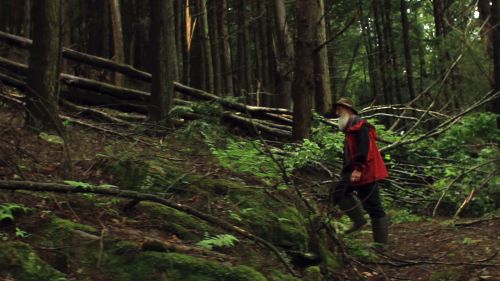lordville: Tom Wessels, Forest Forensics, The Walking Purchase Treaty Having spent a lot of time alo
lordville: Tom Wessels, Forest Forensics, The Walking Purchase Treaty Having spent a lot of time alone walking and hiking through the woods in Lordville, I never ran into another human. The impact of this on me made me reflect on the age of the trees here and what was their historical time frame. Who had been here before me — how did this correspond to a historical time period, what was happening on this land or in this proxmity 100 years ago? How does culture influence land and how does land influence culture? I invited Tom Wessels, author of Forest Forensics and Reading the Forested Landscape, to read the landscape in Lordville. On one of the slopes, Tom pointed out a tree that had been struck by lightning about 100 years ago— and indicated that the strange bend in the tree was where the lightning struck. Tom also indicated that the trees in this slope had root systems that went back to the early 1700s. Some of these trees were standing during the signing of the 1737 Walking Purchase Treaty. The area of land claimed by the Penns in the treaty is a few hundred miles south of Lordville in the state of Pennsylvania — one of the boundaries of this land tract is the Delaware River which runs through Lordville and is the dividing boundary between New York and Pennsylvania. The Lenape/Delaware lived in the woods of Lordville as well. The following is excerpted from a page on the Official Delaware Indian Tribe website: THE WALKING PURCHASE In Lenape history there is the story of the “Walking Purchase” which took place in 1737. William Penn had always dealt fairly with the Lenape, but after he returned to England his sons and other agents began to sell land to pay their creditors, and these were lands which were still owned by the Lenape. In order to convince the Lenape to part with the land, the Penns falsely represented an old, incomplete, unsigned draft of a deed as a legal contract. They told the Lenape that their ancestors some fifty years before had signed this document which stated that the land to be deeded to the Penns was as much as could be covered in a day-and-a-half’s walk. Believing that their forefathers had made such an agreement the Lenape leaders agreed to let the Penns have this area walked off. They thought the whites would take a leisurely walk down an Indian path along the Delaware River. Instead, the Penns hired three of the fastest runners, and had a straight path cleared. Only one of the “walkers” was able to complete the “walk,” but he went fifty-five miles. And so by means of a false deed, and use of runners, the Penns acquired 1200 square miles of Lenape land in Pennsylvania, an area about the size of Rhode Island! The Lenape people complained about the way the “walk” had been done. Lenape chief Lappawinsoe expressed the frustration and dissatisfaction of the Lenape when he said: [the white runners] should have walkt along by the River Delaware or the next Indian path to it… should have walkt for a few Miles and then have sat down and smoakt a Pipe, and now and then have shot a Squirrel, and not have kept up the Run, Run all day. Nonetheless, the Lenape felt honor-bound to fulfill what they thought their ancestors had agreed to, and thus began their movement westward. The Lenape were given place after place. Each time it was promised by the government that it would be their permanent home, only to have to move again. Their trek, which lasted 130 years, finally brought them to what was known as Indian Territory, now Oklahoma. http://delawaretribe.org/blog/2013/06/27/the-walking-purchase/ “The Walking Purchase (or Walking Treaty) was a purported 1737 agreement between the Penn family, the proprietors of Pennsylvania and the Lenape (also known as the Delaware). By it the Penn family and proprietors claimed an area of 1,200,000 acres (4,860 km²) and forced the Lenape to vacate it. The Lenape appeal to the Iroquois for aid on the issue was refused. In Delaware Nation v. Pennsylvania (2004), the current nation claimed 314 acres (1.27 km2) included in the original purchase, but the US District Court granted the Commonwealth’s motion to dismiss. It ruled that the case was nonjusticiable, although it acknowledged that Indian title appeared to have been extinguished by fraud. This ruling held through the Unites States court of appeals. The US Supreme Court refused to hear the case.” http://en.wikipedia.org/wiki/Walking_Purchase -- source link
Tumblr Blog : lordville.tumblr.com
#envhist#tom wessels#walking purchase

